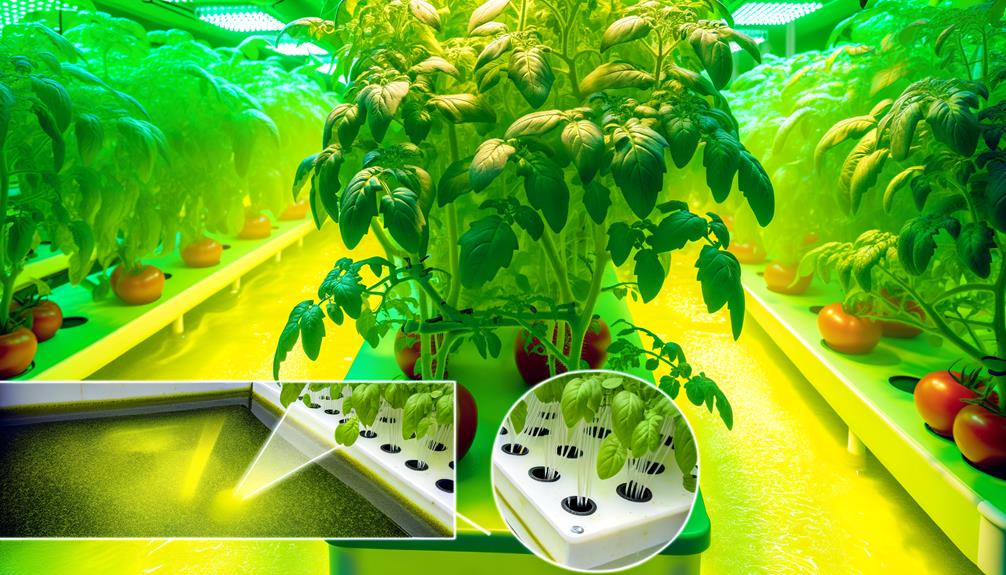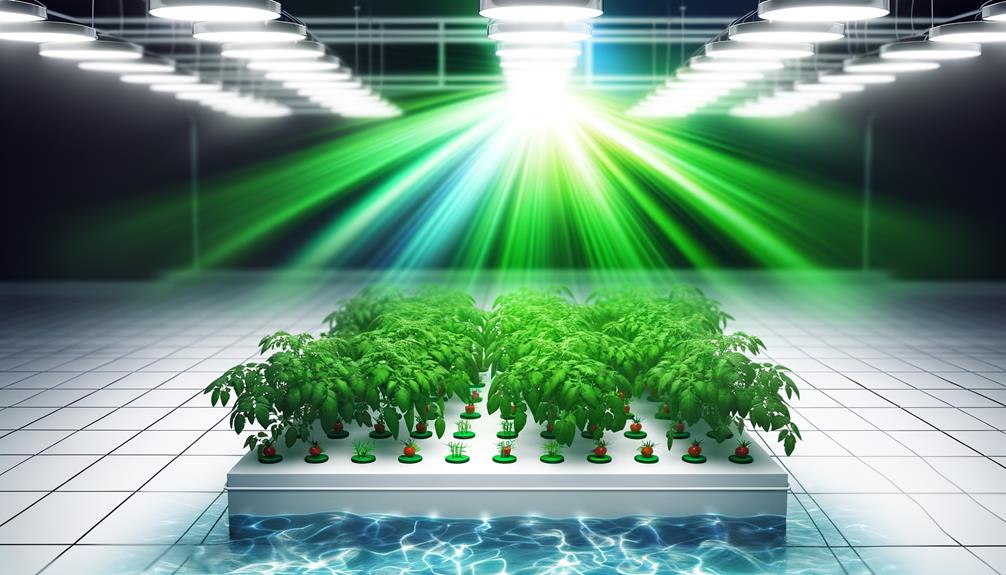What Is the Best Container to Grow Tomatoes Hydroponically
For hydroponic tomato cultivation, the best container choices include buckets, net pots, and PVC pipes. Buckets offer ample root space, effective nutrient management, and prevent algal growth due to their opaque materials.
Net pots guarantee excellent aeration and root support, aiding nutrient uptake and reducing root rot. PVC pipes are particularly advantageous for vertical systems, promoting efficient space usage and consistent nutrient delivery.
Each container type supports different hydroponic setups like Deep Water Culture, drip systems, and aeroponics, providing scalability and resource efficiency for both home and commercial growers. Additional insights are available for optimizing these systems further.

Key Takeaways
- Buckets offer versatility and cost-effectiveness for various hydroponic setups, providing ample root space and preventing algal growth.
- Net pots ensure superior aeration and nutrient uptake, reducing root rot with their perforated design.
- Grow bags provide excellent aeration and drainage, promoting root oxygenation and preventing overwatering.
- PVC pipes are durable, lightweight, and perfect for vertical hydroponic systems, maximizing space efficiency.
Buckets

When selecting containers for hydroponic tomatoes, buckets are a popular choice due to their cost-effectiveness and versatility in accommodating various hydroponic systems.
Their robust structure supports a range of setups, from Deep Water Culture (DWC) to drip systems. Buckets, typically ranging from 5 to 20 liters, allow for ample root space, promoting healthy plant development.
The opaque material prevents light penetration, mitigating algal growth that can disrupt nutrient absorption. Additionally, buckets facilitate efficient nutrient management by integrating easily with air stones and water pumps.
Innovators favor buckets for their adaptability in custom system designs, ensuring precise control over environmental variables. This adaptability makes buckets a cornerstone in optimizing hydroponic tomato cultivation.
Net Pots
In addition to buckets, net pots are integral components in hydroponic systems for growing tomatoes, offering superior aeration and support for the root structure.
These perforated containers facilitate ideal oxygen exchange and nutrient uptake, essential for robust tomato growth.
Constructed from durable plastic, net pots maintain structural integrity under moist conditions while allowing roots to expand freely.
The design minimizes root rot risk by preventing waterlogging.
For practical application, select net pots with a diameter of 3-6 inches to balance plant support and root space.
Using hydroponic media such as clay pebbles or coco coir within the net pot enhances nutrient delivery and stability.
Incorporating net pots into your hydroponic setup can greatly improve tomato plant health and yield. The net pots provide excellent aeration and drainage, preventing root rot and promoting strong root development. This allows you to grow hydroponic tomatoes successfully by ensuring optimal nutrient absorption and stability for the plants. Additionally, net pots support proper oxygen exchange, which enhances overall plant growth and increases fruit production.
Mason Jars

Mason jars present a viable option for hydroponic tomato cultivation due to their straightforward assembly process, making them accessible for both novice and experienced growers.
Their compact design is advantageous for maximizing space efficiency, particularly in constrained environments such as urban settings.
In addition, Mason jars are a cost-effective solution, offering an affordable alternative to more specialized hydroponic containers without compromising functionality.
Easy Assembly Process
Utilizing mason jars for hydroponic tomatoes involves a straightforward assembly process that simplifies both setup and maintenance for growers.
Begin by selecting appropriately sized mason jars, ensuring they can accommodate root growth and nutrient solutions.
Drill a hole in the lid to fit a net pot, which will hold the tomato seedling.
Fill the jar with a nutrient-rich solution, maintaining precise pH levels for ideal plant health.
Insert the seedling into the net pot with a suitable growing medium, such as rock wool or clay pellets, to support root structure.
Employ an air pump with an air stone to oxygenate the nutrient solution, promoting robust root development.
This method offers an efficient and effective means for hydroponic tomato cultivation.
Space Saving Design
The compact and modular nature of mason jars makes them an ideal choice for hydroponic tomato cultivation in environments where space is at a premium. Their vertical stacking potential and small footprint enable efficient utilization of limited areas, such as urban apartments or indoor gardens.
Additionally, mason jars facilitate precise root observation, aiding in early detection of nutrient deficiencies or diseases. The transparent glass allows for maximum light penetration, essential for photosynthesis.
When paired with net pots and hydroponic mediums like clay pebbles or rock wool, mason jars guarantee robust root aeration. This setup also simplifies nutrient solution management, making it easier to maintain the necessary pH and electrical conductivity levels.
Therefore, mason jars offer an innovative, space-efficient solution for hydroponic tomato growth.
Cost-Effective Option
As a cost-effective option, mason jars offer an affordable and accessible entry point for hydroponic tomato cultivation, leveraging their widespread availability and low initial investment.
Mason jars, commonly made of glass, provide a transparent environment that facilitates root observation and early detection of nutrient imbalances. Their compact size is ideal for limited spaces, making them a practical choice for urban gardeners.
To optimize growth, employ a nutrient film technique (NFT) or deep water culture (DWC), ensuring a consistent nutrient supply. However, regular monitoring of pH levels and light exposure is critical to prevent algal growth.
While mason jars may not be scalable for larger yields, their simplicity and cost-effectiveness make them an excellent starting point for hydroponic novices.
Grow Bags
Frequently employed in hydroponic systems, grow bags offer excellent aeration and drainage, essential for the ideal growth of tomato plants.
Composed typically of breathable materials like fabric or felt, grow bags facilitate maximum root oxygenation, preventing root rot and promoting robust plant health.
The permeability of these containers allows for superior water regulation, mitigating the risk of overwatering—a common issue in hydroponic cultivation.
Additionally, grow bags are versatile and adaptable to various hydroponic setups, including wick systems and drip irrigation.
Their lightweight and flexible nature make them easy to maneuver and adjust as plants mature.
For best results, confirm grow bags are placed in a well-ventilated area to maintain consistent airflow around the roots.
PVC Pipes

PVC pipes offer a robust solution for hydroponic tomato cultivation, particularly through space-saving vertical systems that optimize limited growing areas.
Their inherent efficiency in nutrient delivery guarantees minimal waste and uniform nutrient distribution.
Additionally, the material's durability and lightweight nature facilitate easy installation and maintenance, making it a practical choice for both commercial and home growers.
Space-saving Vertical Systems
Vertical hydroponic systems utilizing PVC pipes offer an efficient and space-saving solution for cultivating tomatoes, particularly in environments with limited horizontal space.
These systems maximize vertical real estate, allowing multiple plants to be stacked in tiers. PVC pipes serve as conduits for nutrient-rich water, guaranteeing consistent hydration and nutrient delivery to plant roots.
The modularity of PVC allows for customizable configurations, enhancing scalability and adaptability for varied spatial constraints. Additionally, the lightweight nature of PVC facilitates ease of installation and maintenance.
To optimize plant growth, it is imperative to ascertain proper spacing between plants to avoid competition for light and nutrients. Incorporating supplemental lighting can further enhance photosynthetic efficiency in vertically arranged plants.
Nutrient Delivery Efficiency
Guaranteeing nutrient delivery efficiency in hydroponic systems utilizing PVC pipes hinges on the meticulous design and maintenance of the nutrient solution flow, which directly impacts plant health and productivity.
Maximizing this system involves understanding fluid dynamics and plant nutrient uptake. For innovative hydroponic enthusiasts, consider these critical factors:
- Flow Rate: Maintain a consistent flow rate to guarantee even nutrient distribution.
- Pipe Diameter: Select appropriate pipe diameters to balance flow and prevent clogging.
- Aeration: Integrate oxygenation techniques to enhance nutrient absorption.
- Regular Cleaning: Prevent biofilm formation and nutrient blockage through routine cleaning.
Employing these strategies guarantees a robust nutrient delivery system, fostering ideal tomato growth.
Durable and Lightweight Material
Given their exceptional durability and lightweight properties, polyvinyl chloride (PVC) pipes are an ideal choice for constructing hydroponic systems tailored for tomato cultivation.
PVC pipes exhibit resistance to corrosion and chemical degradation, guaranteeing longevity and consistent performance. Their light weight facilitates easy installation and reconfiguration, vital for scalable hydroponic setups.
In addition, PVC's structural integrity supports the weight of mature tomato plants and associated hardware without deformation.
Scientifically, the smooth interior surface of PVC pipes minimizes frictional losses, enhancing nutrient solution flow and distribution.
For practical implementation, opt for food-grade PVC to guarantee the safety of consumables.
This material's adaptability allows for the creation of bespoke system designs, maximizing spatial efficiency and optimizing plant growth conditions.
Dutch Buckets
Dutch Buckets, also known as Bato buckets, provide an efficient and scalable solution for cultivating hydroponic tomatoes due to their superior drainage and aeration properties.
These containers are particularly advantageous for large-scale and commercial operations. The design allows for optimal nutrient delivery and root oxygenation, essential for robust tomato growth.
Key benefits include:
- Scalability: Easily expanded to accommodate growing needs.
- Efficient Drainage: Prevents root rot and guarantees nutrient circulation.
- Aeration: Promotes healthy root systems and vigorous plant growth.
- Cost-Effectiveness: Durable and reusable, reducing long-term costs.
Kratky Method Containers

When selecting containers for the Kratky method in hydroponic tomato cultivation, it is imperative to evaluate both the size and material to guarantee optimal growth.
Containers should be sufficiently large, typically around 5 to 10 gallons, to accommodate the extensive root system of tomato plants and support their nutrient and water needs over time.
Additionally, using durable, food-grade plastic containers can prevent chemical leaching and assure longevity, providing a stable environment for the plants.
Container Size Requirements
To guarantee ideal growth of hydroponic tomatoes using the Kratky Method, selecting a container with adequate size is essential for accommodating both root expansion and nutrient solution volume.
An appropriate container guarantees that roots have sufficient space to grow without becoming entangled or suffering from oxygen deprivation. It also maintains a stable nutrient reservoir, reducing the frequency of refills and nutrient imbalances.
Key considerations include:
- Volume: Minimum of 5 gallons per plant to guarantee sufficient nutrient supply.
- Depth: At least 12 inches to accommodate root length.
- Width: Sufficient to prevent root crowding.
- Height: Extra height for air space above the nutrient solution.
Selecting the correct size will facilitate robust growth and high yield.
Material and Durability
Selecting the appropriate material for Kratky Method containers is essential for guaranteeing both durability and compatibility with hydroponic nutrient solutions.
High-density polyethylene (HDPE) and food-grade plastics are recommended due to their resistance to chemical degradation and UV radiation. These materials offer robustness, minimizing the risk of cracks and leaks that could compromise the system.
Additionally, opaque containers are preferable to prevent algae growth by limiting light penetration. Polypropylene and fiberglass-reinforced plastic also present viable options, providing structural integrity and longevity.
When choosing a container, verify it has a stable base to support the weight of mature tomato plants and nutrient solution.
Ultimately, the material selected must balance cost-effectiveness with enduring performance to facilitate successful hydroponic tomato cultivation.
Aeroponic Towers
Aeroponic towers present a sophisticated and efficient solution for cultivating hydroponic tomatoes, leveraging mist-based nutrient delivery to enhance plant growth and yield. This advanced system atomizes nutrient solutions, ensuring prime root oxygenation and nutrient absorption. Aeroponic towers are particularly beneficial in environments where space is limited, as their vertical design maximizes plant density.
Key advantages include:
- Enhanced Growth Rates: Accelerated nutrient uptake promotes faster plant development.
- Water Efficiency: Substantial reduction in water usage compared to traditional methods.
- Pest and Disease Control: Closed system minimizes exposure to pathogens.
- Space Optimization: Vertical structure allows for high-density planting.
These benefits make aeroponic towers an ideal choice for innovative, sustainable hydroponic tomato cultivation.
Wick Systems

Wick systems, a passive form of hydroponics, utilize capillary action to deliver nutrient solutions directly to the plant roots, making them a low-maintenance option for hydroponic tomato cultivation.
This system employs absorbent wicks, typically made from materials like nylon or cotton, which extend from the nutrient reservoir to the growing medium. For best results, containers with excellent aeration and drainage, such as net pots or fabric pots, are recommended. These guarantee efficient oxygenation while preventing root rot.
However, the wick system is best suited for smaller tomato varieties due to its limited nutrient delivery rate. Regular monitoring is essential to avoid nutrient imbalances.
This method offers an innovative, energy-efficient approach for those seeking a sustainable hydroponic solution.
Deep Water Culture
Deep Water Culture (DWC), a highly efficient hydroponic method, submerges plant roots directly into a nutrient-rich, oxygenated solution, which facilitates rapid growth and robust yields for hydroponic tomatoes.
This technique involves a reservoir filled with water and dissolved nutrients, continuously oxygenated by air pumps and air stones. The constant availability of nutrients and oxygen accelerates metabolic processes, essential for vigorous tomato growth.
Key advantages of DWC include:
- Enhanced Nutrient Uptake: Direct root access to nutrients promotes faster growth.
- Oxygenation: Air pumps guarantee roots receive ample oxygen, preventing root rot.
- Simplicity: Fewer moving parts compared to other hydroponic systems, reducing potential points of failure.
- Space Efficiency: Suitable for various container sizes, optimizing space utilization.
Nutrient Film Technique

Another prominent hydroponic method for cultivating tomatoes is the Nutrient Film Technique (NFT), which involves a thin film of nutrient solution flowing continuously over the roots, creating an ideal environment for nutrient absorption and oxygen exchange.
This technique often employs sloped channels, typically made from PVC or food-grade plastic, ensuring consistent nutrient delivery and preventing root drowning.
The key advantage of NFT is its efficiency in using water and nutrients, as the recirculating system minimizes waste. For best results, maintain a slight slope (1-3%), ensuring uniform flow.
Regular monitoring of pH (5.8-6.3) and electrical conductivity (1.8-2.5 mS/cm) is essential.
Given its scalability and resource efficiency, NFT is particularly suited for both commercial and advanced home growers seeking innovation.
Conclusion
In considering ideal containers for hydroponic tomato cultivation, each method—buckets, net pots, mason jars, grow bags, PVC pipes, aeroponic towers, wick systems, deep water culture, and nutrient film technique—presents distinctive advantages and limitations.
The choice ultimately hinges on specific cultivation goals, resource availability, and technical expertise.
Just as Da Vinci's Vitruvian Man embodies a harmonious blend of art and science, selecting the appropriate hydroponic container necessitates a balanced approach, integrating scientific precision with practical application for successful tomato growth.






